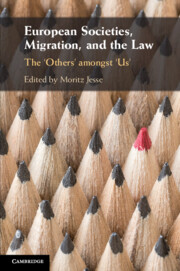Book contents
- European Societies, Migration, and the Law
- European Societies, Migration, and the Law
- Copyright page
- Dedication
- Contents
- Figures and Tables
- Contributors
- Preface
- Acknowledgements
- Abbreviations
- 1 European Societies, Migration, and the Law
- Part I Making the ‘Other’ – The Construction of ‘Otherness’
- Part II The Operation of Legal ‘Othering’ and the National–Foreigner Dichotomy in the EU
- Part III After the Arrival of the ‘Others’ – Reactions to the ‘Refugee Crisis’ of 2015
- 11 The Reception of Asylum Seekers in Europe
- 12 Integration Impossible? Ethnic Nationalism and Refugee Integration in Bulgaria
- 13 Refugees’ Integration into the Labour Market
- Part IV ‘Othering’ in the EU
- Part V European Societies, ‘Otherness’, Migration, and the Law
- Bibliography
- Index
11 - The Reception of Asylum Seekers in Europe
Exclusion through Accommodation Practices
from Part III - After the Arrival of the ‘Others’ – Reactions to the ‘Refugee Crisis’ of 2015
Published online by Cambridge University Press: 13 November 2020
- European Societies, Migration, and the Law
- European Societies, Migration, and the Law
- Copyright page
- Dedication
- Contents
- Figures and Tables
- Contributors
- Preface
- Acknowledgements
- Abbreviations
- 1 European Societies, Migration, and the Law
- Part I Making the ‘Other’ – The Construction of ‘Otherness’
- Part II The Operation of Legal ‘Othering’ and the National–Foreigner Dichotomy in the EU
- Part III After the Arrival of the ‘Others’ – Reactions to the ‘Refugee Crisis’ of 2015
- 11 The Reception of Asylum Seekers in Europe
- 12 Integration Impossible? Ethnic Nationalism and Refugee Integration in Bulgaria
- 13 Refugees’ Integration into the Labour Market
- Part IV ‘Othering’ in the EU
- Part V European Societies, ‘Otherness’, Migration, and the Law
- Bibliography
- Index
Summary
The reception of asylum seekers in Europe is a highly debated topic: while national governments oversee the implementation of reception conditions, European member states are bound by European directives on minimum standards. Asylum seekers in collective reception facilities should be provided with at least a minimum of reception standards, including housing, food, material reception standards, and legal assistance. However, reception practices not only largely differ across member states but also constantly draw boundaries between asylum seekers and the host society through geographical, architectural, and bureaucratic measures. Using case studies from Austria and Italy, this contribution investigates how, on the one hand, certain (minimum) standards are applied in relation to restrictive integration claims and discourses and how, on the other hand, resources (e.g. for integration measures or housing) are strictly bound to exclusive structures that complicate the inclusive partaking of refugees in host societies. It highlights the mechanisms whereby national reception practices amplify the ‘othering’ of migrants in the context of asylum seeking.
- Type
- Chapter
- Information
- European Societies, Migration, and the LawThe ‘Others' amongst ‘Us', pp. 213 - 229Publisher: Cambridge University PressPrint publication year: 2020
- 2
- Cited by



